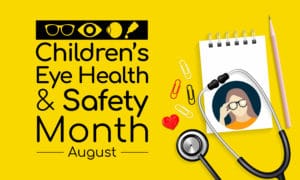August is Child Eye Health and Safety Month
- Posted on: Aug 9 2021
Although the past school year has been anything but ordinary, some things never change. No matter what is happening in the world, we must support our children’s education, and even more importantly, take care of their health. And one thing to pay special attention to when it comes to our young ones is
Things to Watch Out for Before an Exam
It’s important to pay attention to a child’s vision from an early age. We should let the optometrist know if we notice any of the following:
- developmental delays (in infants)
- frequent eye rubbing
- too much blinking
- inability to maintain eye contact
- inability to eye-track
- getting really close to books and screens
All of these can be signs that a child’s vision might be impaired. Also, if we notice anything else that might seem unusual, we mustn’t hesitate to bring it up during an eye exam. What’s more, we should encourage the child to voice their concerns and ask questions as well. It’s never too early for them to learn about their eyes!
What the Doctor Will Be Looking For
A lot of eye conditions develop in early childhood. That is why child eye exams are important — they are designed to catch these conditions as early as possible. Some of those conditions are:
- myopia (nearsightedness)
- eye infections
- conjunctivitis
- drooping eyelid (also called ptosis)
- lazy eye
- congenitalglaucoma
Catching eye conditions early will improve the child’s overall health, as the conditions will be easier to treat. What’s more, it will save them a lot of frustration.
Children do not always understand that their vision is not good, especially if the problem has existed for some time. So they won’t attribute their struggling to read or focus to an eye condition. Rather, they’ll start to think that they’re not as good at school as their peers, which will affect their self-confidence and further academic results. So we need to help them catch and solve these problems as early as possible!
Things to Consider in 2021
Since many schools alternated between in-person and online classes this year, children’s screen time has increased significantly. So it might be a good idea to ask the optometrist about blue-light blocking glasses. The child may need these even if they don’t normally wear glasses.
There are also some other safety precautions we can take to protect our children from UV rays that digital devices put out. For example, we should make sure the child rests their eyes frequently, take breaks away from the screen, and spends some time outside every day.
Frequently Asked Questions About Back-to-School-Exams
Are school exams enough to keep track of my child’s eye health?
Regular eye exams at school are helpful but are not a replacement for the comprehensive eye exam. They might help you discover that there’s a problem, but they may not always be able to diagnose your child’s condition.
When should I start taking my child to eye exams?
By the time they are six months old, a baby should be able to see as well as adults. That includes colors, depth perception, and the ability to focus. So, six months is a good time for your child’s first eye exam. After that, you should have their vision checked at least once a year, maybe even more often if they start wearing glasses or contact lenses.
What else should I consider when scheduling an eye exam?
One more thing to consider is the time you set up an exam. You should pick the time that works for you and your child. When it comes to infants, try to take them when they are alert and in a good mood. With older children, talk to them and decide on the best time for an exam together.
If you have any additional questions, our team is here to help! Set up an appointment and make sure your child is off to a good start for the new school year.
Tagged with: eye health
Posted in: Eye Exam, Eye Health, Uncategorized
